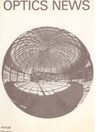
July/August, 1976 Issue
Feature Articles
Optical Materials for Solar-Energy Applications
The application of optical materials to solar-energy utilization is reviewed. It is shown that hundreds of square kilometers of optical materials will be required every year to have a significant input on the United State's energy economy. Most of these materials will have to be fabricated at a very low areal cost. Various high-volume, low-cost production processes applicable to solar-optical materials are presented. Major challenges to the optical technologist will be to control the optical properties of materials being fabricated at very high production rates and to develop new low-cost optical materials.
by D. M. MattoxThere has always been a close relationship between the sciences of optics and vision. The reason is, of course, that the ultimate consumer of the products resulting from optical transformation has traditionally been the human visual system. So it is no surprise that names like Newton, Thomas Young, Brewster, Airy, Helmholtz, and Rayleigh loom as large in the history of vision as they do in the history of optics. After all, the natural history of optical phenomena would include the properties of the final detector, which until relatively recently was always the human eye.
by Gerald WestheimerYou might reasonably ask why I have chosen the topic, "Lasers and Free Enterprise." What is the relationship between lasers and free enterprise? I would respond by saying that I believe it can be proven that the economic system that we enjoy in the United States—the free-enterprise system—is the most prolific and productive economic system ever devised. The proof lies in the fact that free enterprise has created the highest standard of living, the finest quality of life ever known; and entrepreneurship as represented by the laser industry is the essence of the free-enterprise system.
by Herbet M. Dwight

![Manual probe system with needles for test of semiconductor on silicon wafer. [A. Morozov / Getty]](https://opnmedia.blob.core.windows.net/$web/opn/media/images/articles/2025/1125/departments/202511-cover-web.jpg?ext=.jpg)
![Researcher Clara Saraceno in the lab. [Image by Carsten Behler Photography]](https://opnmedia.blob.core.windows.net/$web/opn/media/images/articles/2025/1025/departments/202510-cover-web.jpg?ext=.jpg)
